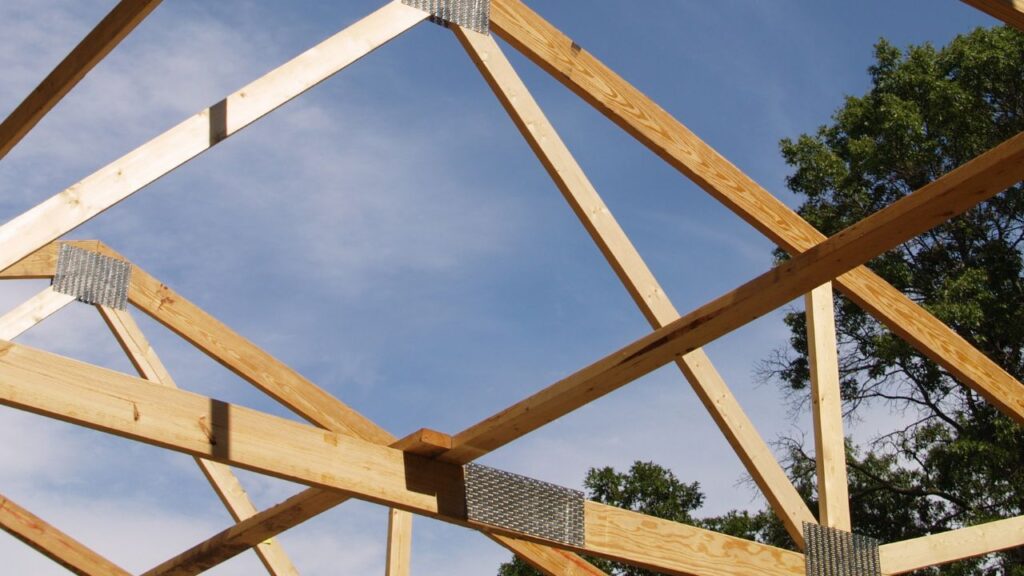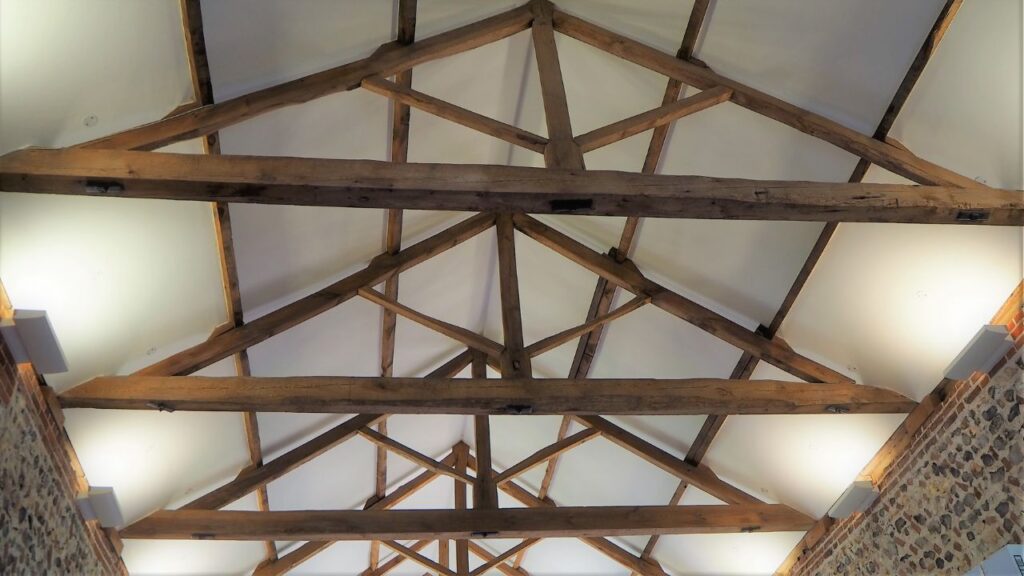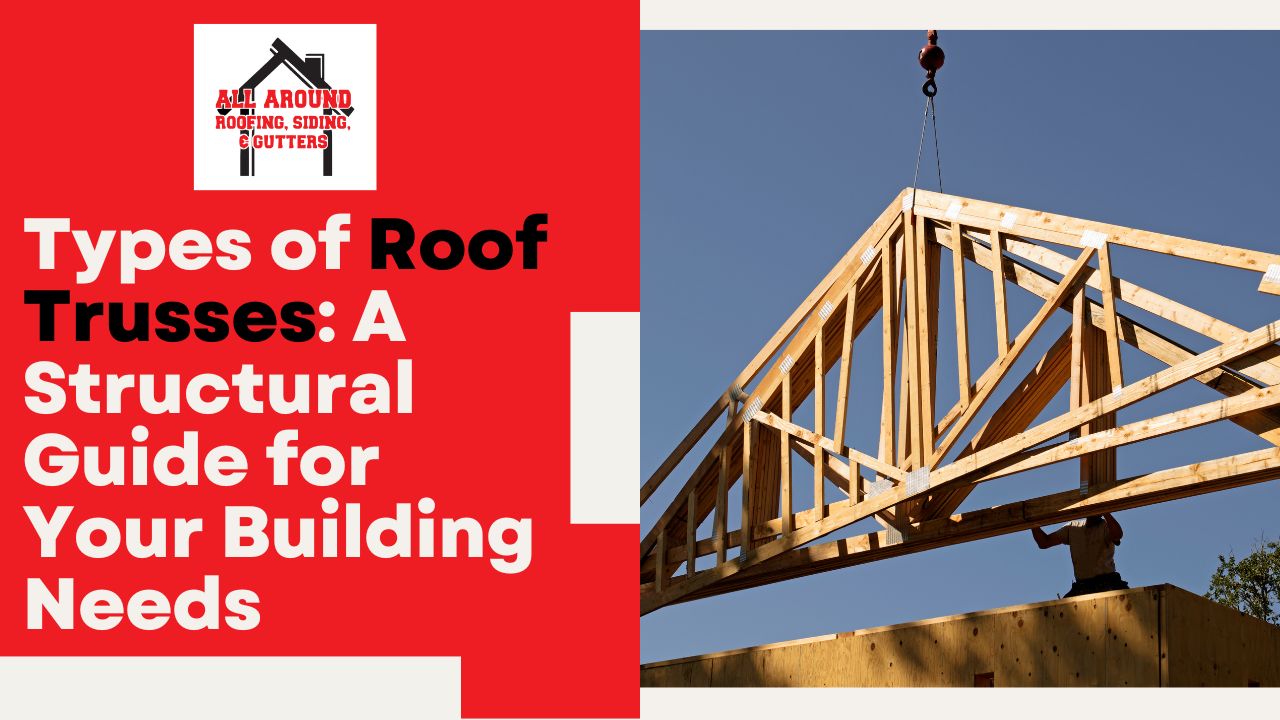Roof trusses provide support for all the components of a roof, making them a crucial structural element of any building, and can be used in a variety of architectural designs. There are different types of roof trusses that are constructed from triangulated timbers, which provide strength and stability to the roof structure.
In this blog post, we will discuss the different types of roof trusses and their uses, helping homeowners understand the significance of selecting the appropriate roof truss for their situation and its function in a building’s structural integrity.
16 Different Types Of Roof Trusses For Your Home
Let’s delve in to understand the different types of roof trusses, each bringing unique designs and structural advantages to your home:
#1. Fink Truss

The first on our list is a Fink truss, which is a strong and cost-effective roof structure commonly used in both homes and businesses. Its V-shaped design efficiently spans long distances and is easy to install. Available in various sizes, it’s ideal for short-span and high-pitched roofs, offering versatility.
The truss can be adapted into other types, like the Double Fink. Its lightweight design efficiently distributes weight, making it a popular choice for housing projects.
#2. Mono Truss
Mono trusses are perfect for roofs sloping in one direction and are often used in porch constructions. Their asymmetrical design caters to specific architectural needs, offering both functionality and visual appeal. These single-span trusses are strong and distribute loads evenly, making them ideal for industrial and commercial buildings.
With spans between 16 to 40-feet, mono trusses are a cost-effective and efficient choice for roofs with a single slope and are commonly found in extensions or modern builds.
#3. Scissor Truss
Scissor trusses, commonly used in residential roofs, have a distinctive zigzag shape that creates visually appealing interiors. Their sloped design prevents water accumulation, reducing the risk of damage. With a straightforward layout and marked joints, they are easy to repair and maintain.
These trusses offer customization options, adapting to various project needs, and are cost-effective by eliminating the need for extra support. Made of timber or steel, scissor trusses are strong, stable, and versatile.
#4. Gable Truss

This option is another favorite of homeowners because of the many benefits it offers. These trusses support gable roofs, allowing effective water drainage and protecting the structure from weather damage. Because of the improved ventilation provided by their design, interior spaces remain at more stable temperatures, reducing the need for excessive heating or air conditioning.
Gable roofs are also renowned for being more affordable to construct and economically designed. The pitched shape of a gable roof adds extra space, enabling attics or vaulted ceilings, which give homeowners more room for living or storage. Their popularity is attributed to their straightforward and efficient design.
#5. Attic Truss
Attic trusses, also known as “room in the roof” trusses, serve as both roof and floor, providing extra living space without structural changes. They feature an open space for room construction, offering flexibility in design for additional living areas like bedrooms or offices.
Opting for attic trusses is an easy way to maximize your home space without expanding the footprint, which can add property value to your home. These trusses, popular for their flexibility and energy efficiency, leave room for creative layouts and contribute to improved home insulation.
#6. Pratt Truss
The next option is the Pratt truss, which is a structure made of vertical and diagonal beams and is known for its simplicity. The vertical beams are in compression and the diagonal beams are in tension, creating a sturdy and economical design. Suitable for structures with mainly vertical loads, Pratt trusses offer durability, lightweight construction, and equal force distribution.
Homeowners should consider them for affordability, ability to easily cover longer spans, and their capacity to efficiently carry loads with smaller cross-sections compared to other systems.
#7. Warren Truss
A Warren truss is a lightweight structure with an equilateral triangle design, formed by longitudinal beams connected by angled cross-beams. Known for evenly distributing loads, it’s cost-effective, durable, and suitable for long-span structures.
However, it’s less efficient with concentrated point loads. Warren trusses are a wise choice for homeowners due to their affordability and strength, especially in situations where loads are evenly distributed.
#8. K Truss
A K truss is a sturdy and durable structural system with modified member arrangements, similar to a Pratt truss. It consists of vertical and diagonal members, with shortened vertical beams for enhanced resistance to flexural stresses. Suitable for long-span structures with evenly distributed loads, K trusses efficiently carry significant weight.
While slightly more complex, they offer benefits like reduced compression in vertical members, potentially lowering material usage and costs. In situations where long-span structures need to support evenly distributed loads, homeowners should consider K trusses due to their durability and affordability.
#9. Gambrel Truss
A Gambrel truss is a roof design found in barns, sheds, and homes. It offers a larger open span and steeper pitch than traditional roofs, aiding drainage. Typically made of wood or steel, Gambrel trusses have a distinctive appearance, enhancing aesthetics.
Cost-effective with a simple design, they provide additional living or storage space due to their almost vertical lower slope. Gambrel trusses are ideal for homeowners seeking an economical and visually appealing solution that also maximizes space.
#10. King Post Truss

A king post truss is a simple triangular structure commonly used to support pitched or sloping roofs in residential and commercial buildings. It comprises a vertical member (king post), a horizontal beam (tie beam), and two sloping rafters. Known for cost-effectiveness, versatility, and durability, king post trusses suit various architectural styles and can handle heavy loads, making them practical for structures with significant weight requirements.
The unique design adds visual interest to both the roof and interior, making them a popular choice for homeowners seeking a balance of functionality and aesthetics.
#11. Queen Post Truss
A queen post truss is a structural design with two vertical members, a horizontal tie beam, and additional beams extending to the roof’s peak. Suited for longer spans, it’s commonly used in residential and small commercial buildings. Queen post trusses offer a cost-effective, durable, and versatile solution, as they require fewer materials and are simpler to construct.
They are known for withstanding heavy loads and stress, making them reliable for various building types. Additionally, their unique design adds aesthetic appeal, fitting into both modern and traditional architectural styles. Queen post trusses are ideal for homeowners looking to enhance or upgrade their building’s structure.
#12. North Light Roof Truss
A north light truss is a structure commonly used in industrial buildings for short roof spans. Notable for maximizing natural lighting due to their unique shape, these trusses can reduce the need for artificial lights.
Simple and budget-friendly, north light trusses offer large column-free spaces and are versatile for various building designs, including residential homes and commercial buildings. The truss’s construction ensures durability, making it a practical choice for those seeking well-lit spaces with cost-effective construction.
#13. Raised-Heel Truss
A raised-heel truss has an extended heel at the building’s edge, creating a raised profile. It provides extra space for insulation, enhancing energy efficiency and reducing heating and cooling costs. The design simplifies attic ventilation, prevents ice dams, and is easy to build and install with standard methods. A great choice for homeowners, raised-heel trusses lead to improved energy performance, increased comfort, and long-term savings.
#14. Flat Truss
A flat truss is a structure with horizontal top and bottom chords and diagonal members connecting them, forming triangles to efficiently support roof loads. Common in various constructions, from residences to bridges, flat trusses are a sturdy option.
Flat roof trusses are perfect for when a steep pitch is desired in one direction or for managing rain or snow runoff. Their design allows for efficient weight distribution, making them suitable for a range of applications.
#15. Fan Truss
A fan truss is a roof truss with fan-shaped web members spanning from the top and bottom chords, connected by vertical members. With spans between 33 and 49-feet, fan trusses are a great choice for large projects.
They offer quicker construction due to their fewer parts and increased accessibility for installations. Homeowners should choose fan trusses for their ability to support long spans.
#16. Hip Truss
The last option on our list is a hip truss, which is specifically designed for hip roofs and is characterized by four sloping sides meeting at the top. Composed of interconnected triangles, hip trusses create a robust structure suitable for supporting any roof’s weight.
With spans between 24 and 60-feet, hip trusses accommodate diverse sizes and styles. Made of durable materials like wood or steel, they withstand heavy loads, ensuring reliability in construction projects.
Need Help Deciding Which Roof Trusses Are Best For You?
To sum it up, selecting the right roof truss is crucial for your home’s functionality and safety, in addition to its aesthetic appeal. Before starting the construction process, get expert advice to make sure the truss you choose fits your unique requirements. Take into account variables such as the intended design, load requirements, and roof span.
For best outcomes, it’s a good idea to seek professional advice. Feel free to get in touch with All Around Roofing, Siding & Gutters if you need help choosing the right type of roof trusses for your project. We are the best roof replacement company in the area.
Careful planning will keep your home structurally sound! Call us at (937) 249-1416 for high-quality roofing and home exterior services.


